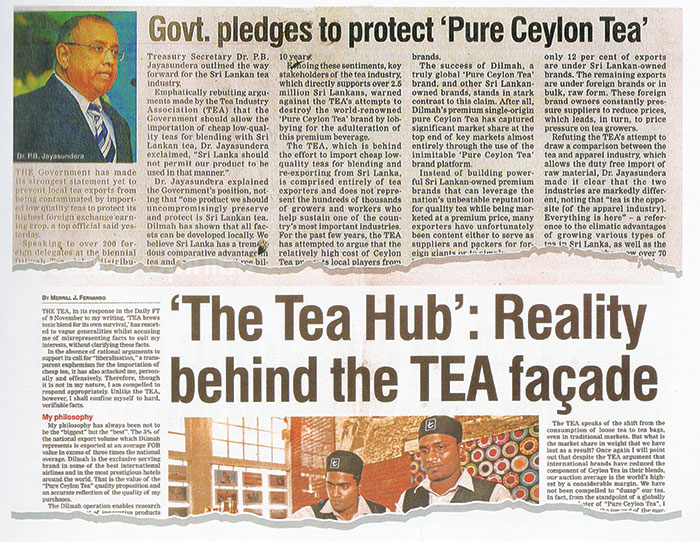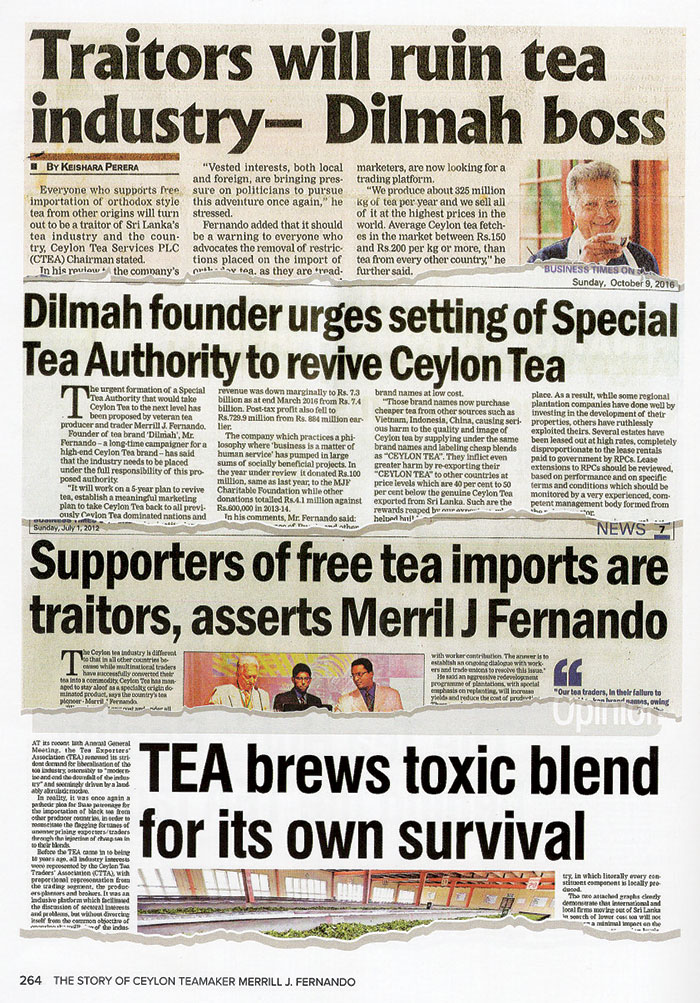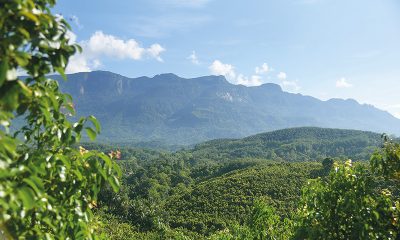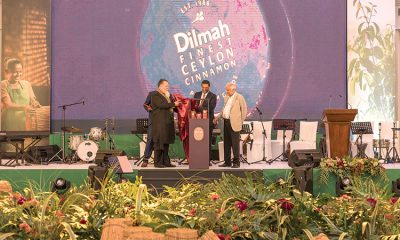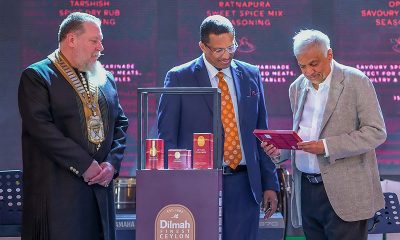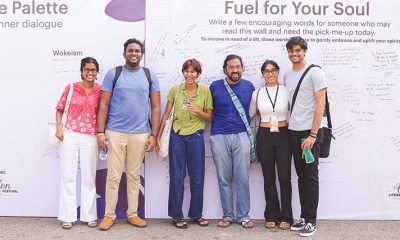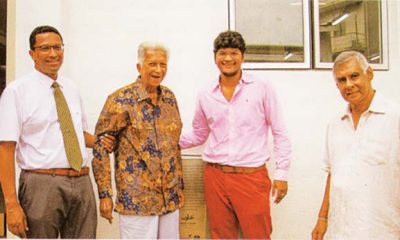Features
My continuing battle against the Tea Hub proposal that would have debased pure Ceylon Tea

Multinationals have long reduced the content of Ceylon tea in packs branded as such
(Excerpted from the autobiography of Merrill J. Fernando)
The ruthless philosophy of the multinational packer and retail supplier is to buy low and sell high in mass markets in which the consumer, through relentless advertising and promotion, has been compelled to accept a well-packaged mediocrity masquerading as excellence. The intrinsic value of a product such as Pure Ceylon Tea and its inherent value proposition is subordinated to profit. Concepts such as genuine product purity and uniqueness of origin have no place in such a world. Such values do not belong in the base culture of mass-marketing of bland, homogeneous products.
The importation of cheap tea from multiple origins would immediately result in the discounting, at the Colombo Auction, of equivalent grades produced in this country, which would invariably be of a higher value than the import. In fact, the cost of any cheap imported tea would be well below our national cost of production, which, for a number of well known reasons, is the highest in the world.
A glut of such low-priced imported tea would depress auction prices overall and adversely impact the grower and producer, who are already burdened by high production costs and diminishing land and worker productivity. In the meantime, the cheap blend, with its desirability enhanced by the legend ‘packed in Sri Lanka/Ceylon,’ will be perceived as genuine Ceylon Tea by the overseas consumer. That perception will cause irreparable damage to the image of Pure Ceylon Tea and, also, to the exporter of the genuine product.
Despite the many abuses it has been subject to over the years, at the hands of multinationals and other traders, who have no respect for either purity or origins, Ceylon Tea is not a commodity as other teas are. Pure Ceylon Tea, of itself and in itself, is a brand and a specialty in the eyes of the consumer. There is no other tea in the world which is recognized internationally by the country of its origin like Ceylon Tea; nor is any other country globally identified by the tea it produces like Sri Lanka/Ceylon.
Up to about 20 years ago, Ceylon Tea was promoted and marketed on that unique value proposition and that memory still lingers in the minds of the older, middle-aged consumer. It was that memory of quality which ensured the success of Dilmah in Australia, despite it being priced well above its competing brands produced by the big multinationals.
Historically, though, commoditization has been the strategy of the trader, the promotion of the brand on the strength of the quality image of Ceylon Tea and then gradually reducing the latter component, thus deluding the overseas consumer and impoverishing the local farmer. Consumers who purchase blindly on brand loyalty do not perceive the gradual erosion in the quality of the cup of tea they drink every day. They will continue to patronize the debased product as a conditioned reflex to compelling advertising and promotion.
A recent example of the strategy described above is the fate of the Russian market, first serviced by our own traders, who, instead of developing own labels when the opportunity arose, chose the easy path and became servitors of the foreign label. The end result was an ignominious exit from the market when the Russian buyer, having established market share on the strength of Ceylon Tea, took his business elsewhere or established his own packing plants in Russia itself.
Value addition, branding, and marketing have, for long, been the weakest features in our export field. Despite all their arguments to the contrary, increasing the total value of our exports using cheap imported tea is not practically possible. The immediate result would be the decline of the export price of Pure Ceylon Tea.
Value-added tea is already being exported at prices ranging from Rs. 600 per kg to Rs. 1,100 per kg. The availability of Ceylon Tea at those prices, automatically weakens the argument for importation of cheap tea, unless the purpose is simply to devalue the export price.
It is also most unlikely that global players in the tea trade, packing in-market, using cheap, multi-origin tea, would rush to Sri Lanka to establish packing centres with the establishment of a Tea Hub. We are far removed from the main markets of the global packers and the only inducements for them to set up operations in Sri Lanka would be the availability of low-cost labour and cheap tea, at rock-bottom prices, the margin savings overriding other disadvantages, such as additional shipping and distribution costs. Such operators will not buy the high-priced Ceylon Tea, unless the proposed massive influx of imported tea drives the local auction prices down to the floor! Is it necessary to emphasize that such a scenario would be the death knell for the local producer?
Unacceptable comparisons, Garment Sector vs. Tea Export Industry
Blending hubs such as Dubai and Rotterdam, examples frequently used by the Tea Hub proponents as ideal models for replication, cannot be equated with Sri Lanka, which is a major producer. Such hubs are commercial centers which facilitate the recycling of products from multiple origins and owe no allegiance to producing countries.
As for the much-touted increase in employment generated by a Tea Hub, it is a myth, as any new blending or packing plant would be fully automated and designed specifically to minimize manual labour. In an industrialized world relentlessly driving towards robotization of processes, manpower is the first designated casualty in any new venture.
The loss of traditional markets for our tea has not been due to price concerns, but largely due to our inadequacies in value addition, marketing, and promotion. The emergence of ‘Dilmah’ as a premier product in Australia and New Zealand, despite being much higher in price than the corresponding products from large multinationals, is proof of the effectiveness of product promotion on the intrinsic strengths of the product itself. It completely negates the argument that multi-origin, cheap blends will override the uniqueness of Pure Ceylon Tea on cost alone.
Our tea has for long been acclaimed as the ‘cleanest tea in the world,’ meeting the Minimum Residue Levels (MRL) stipulated by some of the most demanding markets in the world, such as Japan. The importation of cheap tea from multiple origins, of unregulated hygiene and cleanliness standards, would immediately defile that image irrevocably.
The garment sector in Sri Lanka and the establishment of special Free Trade Zones (FTZs) have been quoted by the TEA (Tea Export Association) as successful examples of special manufacturing enclaves, equivalent to the proposed Tea Hub. In my view those are most inappropriate comparisons, as unacceptable as a ‘chalk and cheese’ equivalent.
The apparel industry exists almost entirely for the servicing of foreign labels, with 95% of the components being imported, whilst, locally, we simply supply the labor. It is. essentially, a massive labor- intensive operation, dedicated to the concept of maximum production at the lowest cost, but embellished with attractive labels, supported by cutting-edge technology, best manufacturing practices, and compliance with international standards, process hygiene and worker safety.
I am not, even for one moment, belittling the success of the garment industry in Sri Lanka, but those are the realities. Sri Lankans do not own the garment industry and are almost entirely dependent on foreign label patronage for continued existence. In that respect alone, the garment industry in Sri Lanka is very similar to the foreign label service provided by Sri Lankan traders to multi-national tea packers. The establishment of a Tea Hub will relegate our tea industry to that unattractive niche. As long as we are in control of the production of the raw material, we have the power to strategize how and where we sell it and at what price.
The establishment of FTZs was to ensure that the finished product, or the raw material, is not leaked out to local markets. As opposed to that, in the plantation industry, possibly over 95% of the raw material and other components are generated locally. It is a totally home-grown industry where the raw material, in its totality, is produced within.
There are only two sustainable ways of increasing the export value of our tea. One is to improve our land and labour productivity and increase annual production and, thus, send more tea to the auction annually. Another is to increase value addition at source to locally-owned brands, thus enhancing the export price. In fact, simply increasing production without a parallel strategy for adding value is also counterproductive.
Auction prices are determined by supply/ demand dynamics which are outside the producers’ area of control and a combination of both volume and quality will not ensure a sustainable revenue increase. Finally, value addition at source to a good quality finished product, namely ‘Pure Ceylon Tea,’ is the surest method of increasing earnings.
Every kilo of tea produced in Ceylon sells at premium prices and, irrespective of other market dynamics, is still considered as a benchmark for overall quality. In such a scenario, the only objective of devaluing it would be for personal gain, in order to compete with the mass-selling, low-priced, multinational trader.
Example of exploitation
The multinational traders’ exploitative strategy in regard to third world products is best illustrated by coffee, grown in countries such as Brazil, Vietnam, Colombia, Ethiopia, Uganda, and many other countries in Africa. In all the countries where coffee is grown in volume, the per capita income of the farmer is a fraction of that of an average farmer in a developed country and miniscule in comparison to the earnings of the average coffee consumer in the West.
Colvin R. de Silva, as Minister of Plantations, was one of the first politicians to publicly and unequivocally articulate this unacceptable disparity. For every plastic cup of coffee sold for USD 3-4 in affluent societies, the farmer in Africa gets five cents. From a kilogramme of coffee sold at USD 2.75, 110 cups can be brewed, translating to a profit margin of over USD 300 for those in between the poor farmer and the rich consumer.
The story of the tea trade in the hands of the multinational tea trader is no different and the cheapening of Ceylon Tea by importing, blending, and re-exporting will contribute further to that unacceptable social and economic disequilibrium.
It is a cardinal rule of all major packers – multinationals – never to purchase their material from one source or origin. Invariably they operate through two or more suppliers. However, because of the excellent and longstanding quality proposition of Ceylon Tea and the confidence we inspired in all the buyers of the major retailers, for many decades Ceylon Tea used to be, if not the major component, the most important ingredient of multinational packs.
Disappointing indications
During a previous Government’s term, the then Finance Minister, Ravi Karunanayake, deluded by the facile arguments of the Tea Hub proponents, facilitated the importation of tea in one of his budgets.
However, my protests against this provision, supported by the then Minister, Ranil Wickremesinghe, resulted in its removal.
I must also admit to being disappointed by the stance of the Planters’ Association, in regard to the issue of the Tea Hub. I recall a strongly-worded press statement (Daily FT, May 17, 2012), in which the PA declared its opposition to the concept. However, as the umbrella body which primarily represents producer interests, I would have expected it to come out far more strongly, vocally, and actively, against an initiative with the very obvious potential to cause serious damage producer.
Sometime in March 2012, immediately after a meeting of the anvil, chaired by me, certain members of the Tea Council met then Plantations Minister, Mahinda Samarasinghe, and advised him that they would boycott future meetings of the Council chaired by me if I continued to oppose the TEA proposals regarding importation of tea. However, they did not breathe a word about this matter at the meeting itself, though that was the most obvious forum for the issue to have been discussed.
Frankly, I was disgusted by the base conduct of those exporters and, by my letter of March 30, 2012, addressed to Minister Samarasinghe, I resigned from the chairmanship of the Council. In my letter I also clearly stated the reasons for my resignation. The Minister accepted it and appointed Tyeab Akberally, Vice Chairman, to the position I relinquished.
The Tea Council was set up in 1989, under the direction of the then Minister of Plantations, Gamini Dissanayake. Its core purpose was resolving the many problems of the entire industry, in a manner that would benefit the industry in its totality; the plantation worker, the producer, the broker, and the exporter, all included. The very submission of a proposal which only addressed the interests of the exporter, to the obvious detriment of all other stakeholders, was in conflict with the remit of the Council.
Dr. P. B. Jayasundera, then Secretary to the Treasury, has always been a strong opponent of the Tea Hub concept. Addressing the CTTA’s 118th Annual General Meeting in late 2012, ironically flanked at the head table by a couple of ardent proponents of the Tea Hub concept, Dr. Jayasundera stated quite unequivocally that the only manner in which the export earnings from tea could be increased was by “creating a new development framework and promoting Ceylon Tea at a premium, setting aside the idea of making the country a Tea Hub”.
Basically, what Dr. Jayasundera supported was to position Sri Lanka as an exclusive centre for value addition to Pure Ceylon Tea and not to convert it to a trading platform for tea from any and every origin.
Bleak certainties
To any impartial observer, it would be clear that the TEA call for liberalization of imports was driven by the sense of insecurity, generated by the rapidly-diminishing profit margins of the proponents. It is a proposal which reflects, with embarrassing clarity, the mindset of the timid exporter and his submission to foreign label pressure. In my many arguments against the Hub, I have frequently requested its supporters to take a moment to consider why a few exporters from Sri Lanka sell comfortably at USD 10 FOB per kilo, whilst others scramble at the bottom, selling at USD 3 per kilo.
All the multinationals operating in Sri Lanka are now manned entirely by Sri Lankans and the industry’s reliance on the former to market our tea should be minimal. However, I am both baffled and saddened by the still very evident orientation and adherence within the industry to archaic multinational thinking and strategy.
In their hunger for short-term gain, the proponents of the Tea Hub are prepared to sacrifice the long-term potential of Pure Ceylon Tea, as well as consign the hundreds of thousands of low-income earners at the producers’ end to permanent impoverishment. In their pursuit of immediate and short term survival, they are prepared to surrender every natural advantage in ‘Pure Ceylon Tea’. The reality is that it is the locally-owned brands exporting exclusively ‘Pure Ceylon Tea,’ which are the flag bearers of the national product on the global stage.
In total, about 12% of this country’s population is dependent, either directly or indirectly, on the plantation economy. Of that proportion, about 90% toil at the producers’ end; plantation workers and residents, small-holders, their dependents, ancillary service suppliers, bought leaf manufacturers, and so on. A decline in the Colombo tea prices, arising from cheap imports, would result in a permanent adverse impact on the lives of this multitude, whilst temporarily enriching a minuscule proportion at the exporters’ end.
Pure Ceylon Tea was, and still is, this country’s greatest asset. It’s a primary home-grown product and identifies Ceylon/Sri Lanka globally. Its real value and significance have either been misinterpreted by successive governments, and many of our local traders, but fully exploited by the multinational who understood its actual worth. Through Ceylon Tea, the country has a product which can stand alone and compete successfully against any tea grown or manufactured in any other country. The maximization of its inherent value proposition simply requires vision, dedication, and integrity of purpose.
For over a century we have permitted Ceylon Tea, a valuable and attractive ‘finished product’ with enormous potential to this country, to be exported by multinational companies to other countries as a ‘raw material’. The importing countries debase its natural quality by blending with inferior tea from other origins, whilst reducing its cost and, with pretty packaging, claim to add value to a less-than-mediocre mix, but still sell it on its intrinsic value as Ceylon Tea. In the process, the tea that is grown by the farmer in our country enriches a chain which has no real link to his country, at the expense of our producer, our farmer, and our plantation worker.
What the proponents of the Tea Hub are advocating so strongly is the replication of the same odious process, in the country of the orign of Ceylon Tea, though they have clothed the proposal in noble rhetoric, as a panacea for all the ills of the tea industry.
Pure Ceylon Tea is still synonymous with quality in the many countries in which it has been a traditional brew, despite the debasement it has suffered at the hands of multinationals who, whilst devaluing its intrinsic goodness, still leveraged the original quality perception in their marketing. Thus, packers determine the quality that they offer the consumer, as the purchasing choice of the latter is limited to what is available on the supermarket shelf.
This compulsion created by the multi-national marketer appears to have created an illusory perception in the minds of certain exporters, especially the Tea Hub proponents, that the cheap, debased tea is actually a consumer demand or preference. Dilmah, however, convincingly exploded this myth with its success in the marketing of quality ‘Pure Ceylon Tea’ in Australia and New Zealand.
Marshalling the opposition
At the beginning of this chapter I referred to the proposal by the then Trade Minister, Lalith Athulathmudali, in 1979, which, to the best of my knowledge, was the first instance when a leading politician presented tea importation as a strategy with potential for economic benefit to the country. To the best of my recollection, there had been no serious discussion about it before, although I am certain that the idea would have been tossed around in tea trading circles. It is really in the 1980s that wider discussion around the concept commenced, eventually gathering momentum until, within a couple of decades, it became an existential threat to the tea industry in its totality.
When I first opposed Athulathmudali’s proposal, I was, essentially, a bulk tea exporter. Dilmah arrived almost 10 years later. Thus, it must be clear to all readers that my opposition to the concept of a Tea Hub, contrary to the arguments of my opponents, was not to protect my interests or my personal brand, but entirely in the larger interests of the tea industry of Sri Lanka. It is for that reason that in this writing I have explained in considerable detail the likely impact of the implementation of such a proposal.
In the years since 2010, during which the Tea Hub proposal has been canvassed by its advocates at all relevant forums, I have used all the resources that I was able to muster to oppose it. My views have been expressed publicly, via newspapers and the electronic media, whilst concurrently being made known at the highest levels of government. I was also able to enlist the support of the Tea Small Holders’ Association and the assistance of the Private Tea Factory Owners’ Association, whilst the Planters’ Association also endorsed my view. However, as I have said earlier in this writing, from the latter I would have welcomed a far more involved engagement in opposition given that, in the event of unrestricted importation, the producer stood to lose more than any other industry group.
Independent journalists of several newspapers, both Sinhala and English, also published articles in support. My friend Herman Gunaratne, plantation owner and specialty tea producer-exporter from Galle, with his passion for Pure Ceylon Tea and his wide contacts within the smallholder segment and private factory owners of the south, was of immense help to me in marshalling support in resistance of the Tea Hub proposal.
The combined strength of the opposition groups, representing about 12% of the country’s population, eventually succeeded in temporarily suppressing a scheme which would have briefly benefited a few thousand people at most. However, the industry needs to be always aware of and be constantly on guard against a resurgence of the Tea Hub movement. If implemented, it will be, for a short while, very profitable for the proponents who are only interested in short-term gain. Since there is money in it, albeit for a handful of profiteers, I suspect that the idea will never be abandoned altogether, irrespective of opposition.
The Tea Hub proposition is a delusional attempt to bridge the chasm between the supplier of tea and the marketer of tea. It is a futile exercise to conflate these two mutually-exclusive concepts. The supplier furnishes a featureless commodity whilst the marketer markets a branded product with a specific identity. There can never connection between these two extremes. Finally, despite all opposition, if the Hub eventually becomes a dismal reality, and the local tea industry collapses as a result – as it surely will – there will not be one expert at that time to acknowledge responsibility and openly say, “Yes, I supported the importation of Orthodox Tea!”
Features
The heart-friendly health minister

by Dr Gotabhya Ranasinghe
Senior Consultant Cardiologist
National Hospital Sri Lanka
When we sought a meeting with Hon Dr. Ramesh Pathirana, Minister of Health, he graciously cleared his busy schedule to accommodate us. Renowned for his attentive listening and deep understanding, Minister Pathirana is dedicated to advancing the health sector. His openness and transparency exemplify the qualities of an exemplary politician and minister.
Dr. Palitha Mahipala, the current Health Secretary, demonstrates both commendable enthusiasm and unwavering support. This combination of attributes makes him a highly compatible colleague for the esteemed Minister of Health.
Our discussion centered on a project that has been in the works for the past 30 years, one that no other minister had managed to advance.
Minister Pathirana, however, recognized the project’s significance and its potential to revolutionize care for heart patients.
The project involves the construction of a state-of-the-art facility at the premises of the National Hospital Colombo. The project’s location within the premises of the National Hospital underscores its importance and relevance to the healthcare infrastructure of the nation.
This facility will include a cardiology building and a tertiary care center, equipped with the latest technology to handle and treat all types of heart-related conditions and surgeries.
Securing funding was a major milestone for this initiative. Minister Pathirana successfully obtained approval for a $40 billion loan from the Asian Development Bank. With the funding in place, the foundation stone is scheduled to be laid in September this year, and construction will begin in January 2025.
This project guarantees a consistent and uninterrupted supply of stents and related medications for heart patients. As a result, patients will have timely access to essential medical supplies during their treatment and recovery. By securing these critical resources, the project aims to enhance patient outcomes, minimize treatment delays, and maintain the highest standards of cardiac care.
Upon its fruition, this monumental building will serve as a beacon of hope and healing, symbolizing the unwavering dedication to improving patient outcomes and fostering a healthier society.We anticipate a future marked by significant progress and positive outcomes in Sri Lanka’s cardiovascular treatment landscape within the foreseeable timeframe.
Features
A LOVING TRIBUTE TO JESUIT FR. ALOYSIUS PIERIS ON HIS 90th BIRTHDAY

by Fr. Emmanuel Fernando, OMI
Jesuit Fr. Aloysius Pieris (affectionately called Fr. Aloy) celebrated his 90th birthday on April 9, 2024 and I, as the editor of our Oblate Journal, THE MISSIONARY OBLATE had gone to press by that time. Immediately I decided to publish an article, appreciating the untiring selfless services he continues to offer for inter-Faith dialogue, the renewal of the Catholic Church, his concern for the poor and the suffering Sri Lankan masses and to me, the present writer.
It was in 1988, when I was appointed Director of the Oblate Scholastics at Ampitiya by the then Oblate Provincial Fr. Anselm Silva, that I came to know Fr. Aloy more closely. Knowing well his expertise in matters spiritual, theological, Indological and pastoral, and with the collaborative spirit of my companion-formators, our Oblate Scholastics were sent to Tulana, the Research and Encounter Centre, Kelaniya, of which he is the Founder-Director, for ‘exposure-programmes’ on matters spiritual, biblical, theological and pastoral. Some of these dimensions according to my view and that of my companion-formators, were not available at the National Seminary, Ampitiya.
Ever since that time, our Oblate formators/ accompaniers at the Oblate Scholasticate, Ampitiya , have continued to send our Oblate Scholastics to Tulana Centre for deepening their insights and convictions regarding matters needed to serve the people in today’s context. Fr. Aloy also had tried very enthusiastically with the Oblate team headed by Frs. Oswald Firth and Clement Waidyasekara to begin a Theologate, directed by the Religious Congregations in Sri Lanka, for the contextual formation/ accompaniment of their members. It should very well be a desired goal of the Leaders / Provincials of the Religious Congregations.
Besides being a formator/accompanier at the Oblate Scholasticate, I was entrusted also with the task of editing and publishing our Oblate journal, ‘The Missionary Oblate’. To maintain the quality of the journal I continue to depend on Fr. Aloy for his thought-provoking and stimulating articles on Biblical Spirituality, Biblical Theology and Ecclesiology. I am very grateful to him for his generous assistance. Of late, his writings on renewal of the Church, initiated by Pope St. John XX111 and continued by Pope Francis through the Synodal path, published in our Oblate journal, enable our readers to focus their attention also on the needed renewal in the Catholic Church in Sri Lanka. Fr. Aloy appreciated very much the Synodal path adopted by the Jesuit Pope Francis for the renewal of the Church, rooted very much on prayerful discernment. In my Religious and presbyteral life, Fr.Aloy continues to be my spiritual animator / guide and ongoing formator / acccompanier.
Fr. Aloysius Pieris, BA Hons (Lond), LPh (SHC, India), STL (PFT, Naples), PhD (SLU/VC), ThD (Tilburg), D.Ltt (KU), has been one of the eminent Asian theologians well recognized internationally and one who has lectured and held visiting chairs in many universities both in the West and in the East. Many members of Religious Congregations from Asian countries have benefited from his lectures and guidance in the East Asian Pastoral Institute (EAPI) in Manila, Philippines. He had been a Theologian consulted by the Federation of Asian Bishops’ Conferences for many years. During his professorship at the Gregorian University in Rome, he was called to be a member of a special group of advisers on other religions consulted by Pope Paul VI.
Fr. Aloy is the author of more than 30 books and well over 500 Research Papers. Some of his books and articles have been translated and published in several countries. Among those books, one can find the following: 1) The Genesis of an Asian Theology of Liberation (An Autobiographical Excursus on the Art of Theologising in Asia, 2) An Asian Theology of Liberation, 3) Providential Timeliness of Vatican 11 (a long-overdue halt to a scandalous millennium, 4) Give Vatican 11 a chance, 5) Leadership in the Church, 6) Relishing our faith in working for justice (Themes for study and discussion), 7) A Message meant mainly, not exclusively for Jesuits (Background information necessary for helping Francis renew the Church), 8) Lent in Lanka (Reflections and Resolutions, 9) Love meets wisdom (A Christian Experience of Buddhism, 10) Fire and Water 11) God’s Reign for God’s poor, 12) Our Unhiddden Agenda (How we Jesuits work, pray and form our men). He is also the Editor of two journals, Vagdevi, Journal of Religious Reflection and Dialogue, New Series.
Fr. Aloy has a BA in Pali and Sanskrit from the University of London and a Ph.D in Buddhist Philosophy from the University of Sri Lankan, Vidyodaya Campus. On Nov. 23, 2019, he was awarded the prestigious honorary Doctorate of Literature (D.Litt) by the Chancellor of the University of Kelaniya, the Most Venerable Welamitiyawe Dharmakirthi Sri Kusala Dhamma Thera.
Fr. Aloy continues to be a promoter of Gospel values and virtues. Justice as a constitutive dimension of love and social concern for the downtrodden masses are very much noted in his life and work. He had very much appreciated the commitment of the late Fr. Joseph (Joe) Fernando, the National Director of the Social and Economic Centre (SEDEC) for the poor.
In Sri Lanka, a few religious Congregations – the Good Shepherd Sisters, the Christian Brothers, the Marist Brothers and the Oblates – have invited him to animate their members especially during their Provincial Congresses, Chapters and International Conferences. The mainline Christian Churches also have sought his advice and followed his seminars. I, for one, regret very much, that the Sri Lankan authorities of the Catholic Church –today’s Hierarchy—- have not sought Fr.
Aloy’s expertise for the renewal of the Catholic Church in Sri Lanka and thus have not benefited from the immense store of wisdom and insight that he can offer to our local Church while the Sri Lankan bishops who governed the Catholic church in the immediate aftermath of the Second Vatican Council (Edmund Fernando OMI, Anthony de Saram, Leo Nanayakkara OSB, Frank Marcus Fernando, Paul Perera,) visited him and consulted him on many matters. Among the Tamil Bishops, Bishop Rayappu Joseph was keeping close contact with him and Bishop J. Deogupillai hosted him and his team visiting him after the horrible Black July massacre of Tamils.
Features
A fairy tale, success or debacle

Sri Lanka-Singapore Free Trade Agreement
By Gomi Senadhira
senadhiragomi@gmail.com
“You might tell fairy tales, but the progress of a country cannot be achieved through such narratives. A country cannot be developed by making false promises. The country moved backward because of the electoral promises made by political parties throughout time. We have witnessed that the ultimate result of this is the country becoming bankrupt. Unfortunately, many segments of the population have not come to realize this yet.” – President Ranil Wickremesinghe, 2024 Budget speech
Any Sri Lankan would agree with the above words of President Wickremesinghe on the false promises our politicians and officials make and the fairy tales they narrate which bankrupted this country. So, to understand this, let’s look at one such fairy tale with lots of false promises; Ranil Wickremesinghe’s greatest achievement in the area of international trade and investment promotion during the Yahapalana period, Sri Lanka-Singapore Free Trade Agreement (SLSFTA).
It is appropriate and timely to do it now as Finance Minister Wickremesinghe has just presented to parliament a bill on the National Policy on Economic Transformation which includes the establishment of an Office for International Trade and the Sri Lanka Institute of Economics and International Trade.
Was SLSFTA a “Cleverly negotiated Free Trade Agreement” as stated by the (former) Minister of Development Strategies and International Trade Malik Samarawickrama during the Parliamentary Debate on the SLSFTA in July 2018, or a colossal blunder covered up with lies, false promises, and fairy tales? After SLSFTA was signed there were a number of fairy tales published on this agreement by the Ministry of Development Strategies and International, Institute of Policy Studies, and others.
However, for this article, I would like to limit my comments to the speech by Minister Samarawickrama during the Parliamentary Debate, and the two most important areas in the agreement which were covered up with lies, fairy tales, and false promises, namely: revenue loss for Sri Lanka and Investment from Singapore. On the other important area, “Waste products dumping” I do not want to comment here as I have written extensively on the issue.
1. The revenue loss
During the Parliamentary Debate in July 2018, Minister Samarawickrama stated “…. let me reiterate that this FTA with Singapore has been very cleverly negotiated by us…. The liberalisation programme under this FTA has been carefully designed to have the least impact on domestic industry and revenue collection. We have included all revenue sensitive items in the negative list of items which will not be subject to removal of tariff. Therefore, 97.8% revenue from Customs duty is protected. Our tariff liberalisation will take place over a period of 12-15 years! In fact, the revenue earned through tariffs on goods imported from Singapore last year was Rs. 35 billion.
The revenue loss for over the next 15 years due to the FTA is only Rs. 733 million– which when annualised, on average, is just Rs. 51 million. That is just 0.14% per year! So anyone who claims the Singapore FTA causes revenue loss to the Government cannot do basic arithmetic! Mr. Speaker, in conclusion, I call on my fellow members of this House – don’t mislead the public with baseless criticism that is not grounded in facts. Don’t look at petty politics and use these issues for your own political survival.”
I was surprised to read the minister’s speech because an article published in January 2018 in “The Straits Times“, based on information released by the Singaporean Negotiators stated, “…. With the FTA, tariff savings for Singapore exports are estimated to hit $10 million annually“.
As the annual tariff savings (that is the revenue loss for Sri Lanka) calculated by the Singaporean Negotiators, Singaporean $ 10 million (Sri Lankan rupees 1,200 million in 2018) was way above the rupees’ 733 million revenue loss for 15 years estimated by the Sri Lankan negotiators, it was clear to any observer that one of the parties to the agreement had not done the basic arithmetic!
Six years later, according to a report published by “The Morning” newspaper, speaking at the Committee on Public Finance (COPF) on 7th May 2024, Mr Samarawickrama’s chief trade negotiator K.J. Weerasinghehad had admitted “…. that forecasted revenue loss for the Government of Sri Lanka through the Singapore FTA is Rs. 450 million in 2023 and Rs. 1.3 billion in 2024.”
If these numbers are correct, as tariff liberalisation under the SLSFTA has just started, we will pass Rs 2 billion very soon. Then, the question is how Sri Lanka’s trade negotiators made such a colossal blunder. Didn’t they do their basic arithmetic? If they didn’t know how to do basic arithmetic they should have at least done their basic readings. For example, the headline of the article published in The Straits Times in January 2018 was “Singapore, Sri Lanka sign FTA, annual savings of $10m expected”.
Anyway, as Sri Lanka’s chief negotiator reiterated at the COPF meeting that “…. since 99% of the tariffs in Singapore have zero rates of duty, Sri Lanka has agreed on 80% tariff liberalisation over a period of 15 years while expecting Singapore investments to address the imbalance in trade,” let’s turn towards investment.
Investment from Singapore
In July 2018, speaking during the Parliamentary Debate on the FTA this is what Minister Malik Samarawickrama stated on investment from Singapore, “Already, thanks to this FTA, in just the past two-and-a-half months since the agreement came into effect we have received a proposal from Singapore for investment amounting to $ 14.8 billion in an oil refinery for export of petroleum products. In addition, we have proposals for a steel manufacturing plant for exports ($ 1 billion investment), flour milling plant ($ 50 million), sugar refinery ($ 200 million). This adds up to more than $ 16.05 billion in the pipeline on these projects alone.
And all of these projects will create thousands of more jobs for our people. In principle approval has already been granted by the BOI and the investors are awaiting the release of land the environmental approvals to commence the project.
I request the Opposition and those with vested interests to change their narrow-minded thinking and join us to develop our country. We must always look at what is best for the whole community, not just the few who may oppose. We owe it to our people to courageously take decisions that will change their lives for the better.”
According to the media report I quoted earlier, speaking at the Committee on Public Finance (COPF) Chief Negotiator Weerasinghe has admitted that Sri Lanka was not happy with overall Singapore investments that have come in the past few years in return for the trade liberalisation under the Singapore-Sri Lanka Free Trade Agreement. He has added that between 2021 and 2023 the total investment from Singapore had been around $162 million!
What happened to those projects worth $16 billion negotiated, thanks to the SLSFTA, in just the two-and-a-half months after the agreement came into effect and approved by the BOI? I do not know about the steel manufacturing plant for exports ($ 1 billion investment), flour milling plant ($ 50 million) and sugar refinery ($ 200 million).
However, story of the multibillion-dollar investment in the Petroleum Refinery unfolded in a manner that would qualify it as the best fairy tale with false promises presented by our politicians and the officials, prior to 2019 elections.
Though many Sri Lankans got to know, through the media which repeatedly highlighted a plethora of issues surrounding the project and the questionable credentials of the Singaporean investor, the construction work on the Mirrijiwela Oil Refinery along with the cement factory began on the24th of March 2019 with a bang and Minister Ranil Wickremesinghe and his ministers along with the foreign and local dignitaries laid the foundation stones.
That was few months before the 2019 Presidential elections. Inaugurating the construction work Prime Minister Ranil Wickremesinghe said the projects will create thousands of job opportunities in the area and surrounding districts.
The oil refinery, which was to be built over 200 acres of land, with the capacity to refine 200,000 barrels of crude oil per day, was to generate US$7 billion of exports and create 1,500 direct and 3,000 indirect jobs. The construction of the refinery was to be completed in 44 months. Four years later, in August 2023 the Cabinet of Ministers approved the proposal presented by President Ranil Wickremesinghe to cancel the agreement with the investors of the refinery as the project has not been implemented! Can they explain to the country how much money was wasted to produce that fairy tale?
It is obvious that the President, ministers, and officials had made huge blunders and had deliberately misled the public and the parliament on the revenue loss and potential investment from SLSFTA with fairy tales and false promises.
As the president himself said, a country cannot be developed by making false promises or with fairy tales and these false promises and fairy tales had bankrupted the country. “Unfortunately, many segments of the population have not come to realize this yet”.
(The writer, a specialist and an activist on trade and development issues . )

